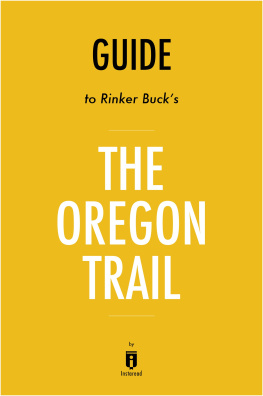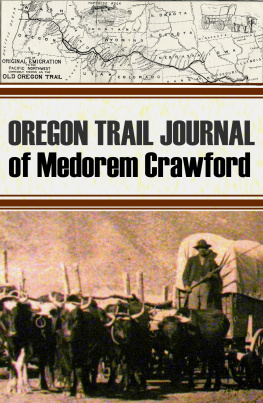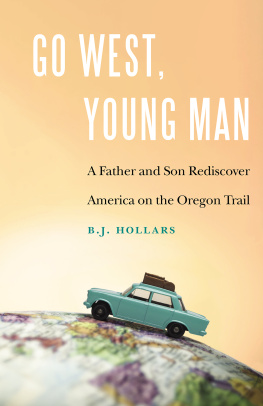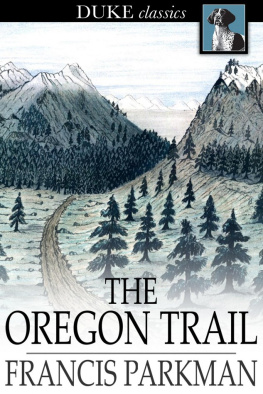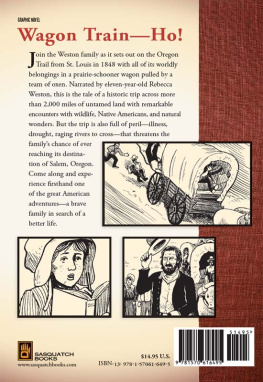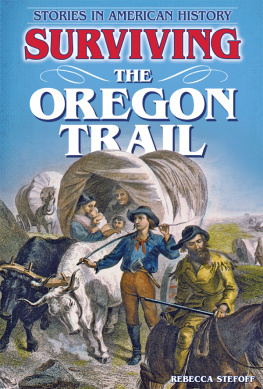Tricia Martineau Wagner - It Happened on the Oregon Trail
Here you can read online Tricia Martineau Wagner - It Happened on the Oregon Trail full text of the book (entire story) in english for free. Download pdf and epub, get meaning, cover and reviews about this ebook. year: 2015, publisher: Globe Pequot, genre: Detective and thriller. Description of the work, (preface) as well as reviews are available. Best literature library LitArk.com created for fans of good reading and offers a wide selection of genres:
Romance novel
Science fiction
Adventure
Detective
Science
History
Home and family
Prose
Art
Politics
Computer
Non-fiction
Religion
Business
Children
Humor
Choose a favorite category and find really read worthwhile books. Enjoy immersion in the world of imagination, feel the emotions of the characters or learn something new for yourself, make an fascinating discovery.

- Book:It Happened on the Oregon Trail
- Author:
- Publisher:Globe Pequot
- Genre:
- Year:2015
- Rating:3 / 5
- Favourites:Add to favourites
- Your mark:
- 60
- 1
- 2
- 3
- 4
- 5
It Happened on the Oregon Trail: summary, description and annotation
We offer to read an annotation, description, summary or preface (depends on what the author of the book "It Happened on the Oregon Trail" wrote himself). If you haven't found the necessary information about the book — write in the comments, we will try to find it.
It Happened on the Oregon Trail — read online for free the complete book (whole text) full work
Below is the text of the book, divided by pages. System saving the place of the last page read, allows you to conveniently read the book "It Happened on the Oregon Trail" online for free, without having to search again every time where you left off. Put a bookmark, and you can go to the page where you finished reading at any time.
Font size:
Interval:
Bookmark:

It Happened on the Oregon Trail
To buy books in quantity for corporate use
or incentives, call (800) 962-0973
or e-mail premiums@GlobePequot.com .

Copyright 2005, 2014 by Morris Book Publishing, LLC
ALL RIGHTS RESERVED. No part of this book may be reproduced or transmitted in any form by any means, electronic or mechanical, including photocopying and recording, or by any information storage and retrieval system, except as may be expressly permitted in writing from the publisher. Requests for permission should be addressed to Globe Pequot Press, Attn: Rights and Permissions Department, PO Box 480, Guilford, CT 06437.
Map by Tony Moore Morris Book Publishing, LLC
Layout: Adam Caporiccio
Project editor: Staci Zacharski
Wagner, Tricia Martineau
It happened on the Oregon Trail / Tricia Martineau Wagner. 2nd ed.
p. cm. (It happened in series)
Includes bibliographical references and index.
ISBN 978-0-7627-7220-9
1. Oregon National Historic TrailHistoryAnecdotes. 2. Frontier and pioneer lifeWest (U.S.)Anecdotes. 3. Overland journeys to the PacificAnecdotes. 4. West (U.S.)History19th centuryAnecdotes. 5. West (U.S.)BiographyAnecdotes. I. Title. II. Series.
F597.W34 2004
978.02dc22 2004057998
Printed in the United States of America
10 9 8 7 6 5 4 3 2 1
In memory of my mother, Merreck E. Martineau, who said everything beautifully
We can all be thankful for the courageous pioneers who took time to write in their diaries and journals and who later offered their reminiscences about their cross-country treks over the westward trails. Without their insight into this fascinating period in American history, our understanding of it would be much poorer. The voices of these ordinary people who endured an extraordinary experience teach us that everyone has a story.
This book came to fruition with generous assistance from the following people:
Those who pointed me in the right direction when I began my research: Kevin Howard, Gordon Howard, Dean Knudsen, and Art Johnson.
My editors at Globe Pequot Press: Charlene Patterson, whose expert direction made the editing process simply enjoyable; Erin Turner, who took me to a new level; Shelley Wolf, whose attention to detail brought the manuscript together; and Courtney Oppel and Staci Zacharski, who skillfully oversaw the second edition revisions.
Samantha M. Scarf, Assistant to the Director at the Rufus Porter Museum, Bridgton, Maine, for her research assistance about Rufus Porter.
Beth Radmall Olsen, for her willingness to share her wealth of knowledge of the Rebecca Winters story, and all the descendants and friends of Rebecca Winters, particularly Norma Winters Freeman, great-granddaughter of Rebecca Burdick Winters, for her patience and diligence in reviewing the facts so I could get the story right. Likewise I thank William J. Curtis for sharing his research on Emily Fisher.
Dr. Robert Munkres, for critiquing the book and offering valuable suggestions.
For their assistance in uncovering historical documents and newspaper articles, Doris E. Onorato at the Van Allen House Heritage Center in Mt. Pleasant, Iowa; Vickie Clause at the North Platte Valley Historical Association in Gering, Nebraska; and Janice Schultz at the Mid-Continent Public Library in Independence, Missouri.
Allen Harrison and John Cook from the National Oregon and California Trail Center in Montpelier, Idaho, for information on their museum.
Wallace DeYoung, who figured out the value of a modern dollar in 1850.
For their continual assistance, the staffs at Dublin Public Library (CA) and the San Ramon Public Library (CA), especially Robin Calogne and Steve Ginochio.
Kevin Fitzgerald, for his technical support and expertise, which got me started. Thank you, my friend.
The value of constant friends cannot be underestimated. Thank you, Melissa Johnson, Tania De Young, Nancy Mills, Joan Rush, and Janet Chi for the kind words.
My husband and best friend, Mark, who lead me kicking and screaming into the world of computers, which did indeed simplify my life. His love and encouragement made my dream come true.
Our children, Kelsey Merreck and Mitchell Dale, for listening to all my stories with wide-eyed interest and for sharing in my excitement. Always follow your dreams.
No two journeys over the Oregon Trail were the same. For some, the overland trip was a carefree and scenic experience of a lifetime. Unencumbered by accident, disease, or misfortune, theirs was an adventure-filled, if not a romantic, affair. For others, the cross-country trek was nothing short of grueling, with unexpected hardships and unbearable heartaches. They experienced intolerable extremes of weather; lacked the basic necessities of food, water, and shelter; and witnessed inconceivable human behavior.
When the wagon train era began in the 1840s, thousands of courageous emigrants left behind the America they knew and traveled into uncharted territory across unfamiliar terrainat times unsure of the route, let alone what to expect ahead. West of the Missouri River towns was a wild frontier as foreign to them as living in a space station seems to us today.
The flood tide of emigrants over westward trails began as a trickle and evolved into a tidal wave that left the Native Americans overwhelmed by the sheer volume of trespassers. Caught up in the Oregon Fever, the emigrants were collectively driven toward fresh horizons, and thus the caravans of wagons began rolling westward. The citizenry of the United States felt it was their right and destiny to expand their land holdings from the Atlantic coast to the Pacific coast. In 1845 a New York newspaper editor, John OSullivan, coined the term Manifest Destiny, which explained the collective expansionist determination of the young nation. People from all walks of life viewed the unchartered territory of the West as the land of opportunity. Perhaps it was the chance for a better life, free farmland, economic opportunity with the hope to strike it rich mining gold, the attainment of social freedom, the desire to unite the land as one nation, or simply an adventuresome spirit that led them to leave behind their lives in the eastern United States.
An overwhelming number of emigrants poured into America from the 1830s to the 1860s. The geometric progression of large families with ten or more children drove the expansion of the country. With each son requiring eighty acres of land to support a family, the need for available land pushed families westward. In the span of forty-five short years, the United States went from being a country made up of towns east of the Mississippi River to a nation that stretched from sea to shining sea.
There are several myths about the settlement of the West that need to be dispelled to gain a clear understanding of this time in American history. The first myth is that the Oregon Trail was one long, continuous road. More accurately it was like a network of blood vessels that trailed westward, gathering into a pulsating vein in the vicinity of Fort Kearny, Nebraska. From there the Oregon Trail headed in a westerly direction with additional cutoffs being defined along the way as the travelers sought the quickest route to the Pacific coast.
The second myth involves the image of a single-file line of wagons heading toward the setting sun. In actuality an array of wagons spread out one abreast of the other, row behind row, to avoid the choking dust. The path a caravan took was often a mile wide, due to the natural detours caused by changes in river courses or the necessity of finding available grass and fresh campsites.
Font size:
Interval:
Bookmark:
Similar books «It Happened on the Oregon Trail»
Look at similar books to It Happened on the Oregon Trail. We have selected literature similar in name and meaning in the hope of providing readers with more options to find new, interesting, not yet read works.
Discussion, reviews of the book It Happened on the Oregon Trail and just readers' own opinions. Leave your comments, write what you think about the work, its meaning or the main characters. Specify what exactly you liked and what you didn't like, and why you think so.

